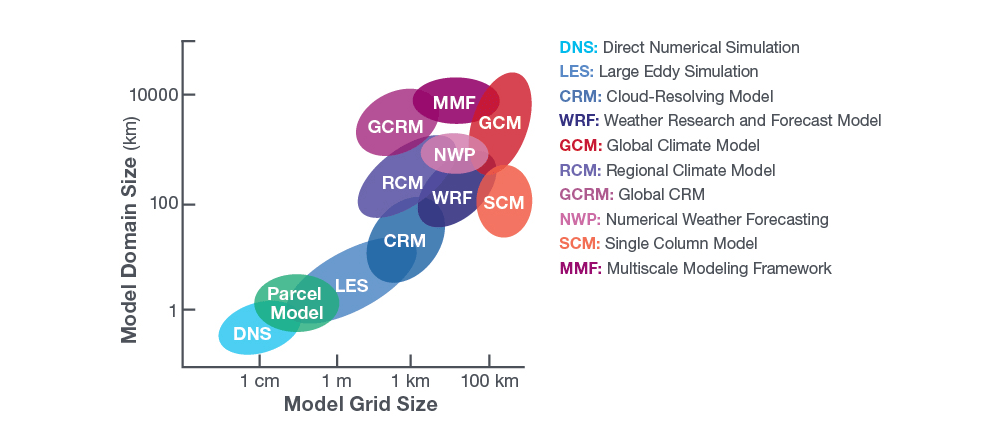Cloud Processes and Measurement
The Cloud Processes and Measurement Group focuses primarily on clouds and the processes that affect them, and that they affect, and on how to represent these processes in models over the entire range of scales relevant for these processes.
Earth’s climate system involves multiple physical processes that act over a wide range of both temporal and spatial scales ranging from microphysics at the level of individual cloud droplets to macrophysics such as cloud systems at regional and global scales. We use multi-scale modeling and observational analyses to investigate the processes essential to clouds, precipitation, land-atmosphere interactions, and urban impacts; by developing parameterizations of these processes for large scale models; and by evaluating the impacts of these processes with regional and global climate models. It also designs and participates in field campaigns, develops new tools: instruments, techniques, and models – to measure, analysis, synthesize, and parameterize data collected during these campaigns.

Illustration of various models used to address multiscale challenges of Earth's climate system.
Research Goals
The group aims to improve process-level understanding of microphysical and dynamical processes that impact the lifecycle of clouds (such as entrainment) to improve their representation in climate models to enable us to better understand and project global change. We also apply our expertise to address energy needs such as solar energy forecasts and quantification of storm impacts on utility outages for improvement of grid resiliency and restoration.
We attempt to improve our understanding of cloud processes through our Advanced TArgeted Cloud Science (ATACS) approach, where development of analyses using observations are guided by theory to target unknown factors in critical processes. We develop novel multi-sensor analyses and retrieval techniques, particularly those using cloud and precipitation radars, Doppler spectra, polarimetry, and multiple frequencies.
We develop novel multi-sensor analyses and retrieval techniques, particularly those using cloud and precipitation radars, Doppler spectra, polarimetry, and multiple frequencies. We also employ advanced computational methods, including signal processing, artificial neural networks, linear programming, and applications using Graphics Processing Unit (GPU) arrays.
Capabilities
- Designing field campaigns to target processes essential to understanding clouds and precipitation
- Advanced radar detection and retrieval techniques, especially those using cloud radar Doppler spectra
- Developing advanced analysis techniques
- Developing parameterizations for important processes such as drizzle onset and drizzle rate
- Measuring and modeling deep convection and entrainment
- Retrievals of mixed-phase clouds
- Quantification of radiative impacts of mixed-phased clouds on Arctic energy budget
- Development of advanced products such as the ARSCL, micro-ARSCL, Merged Sounding, and MICROBASE VAPS (value-added products) from multiple instruments
- Large-eddy simulation (LES) modeling
- Single-column modeling (SCM)
- Regional and Global Climate modeling
- Integration of modeling over a range of scales
-

Michael Jensen
Meteorologist and Group Leader
Cloud Processes & Measurement Science
Environmental and Climate Sciences Department
(631) 344-7021, mjensen@bnl.gov




